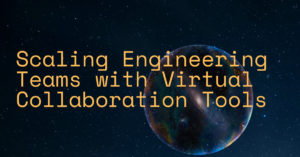
Engineering teams confront particular problems as they grow and develop, which can inhibit productivity, communication, and cooperation.
Coordination and managing a larger and more distributed workforce are among the most challenging issues.
As teams increase, it becomes increasingly more work to guarantee that everyone is on the same page and that critical information is successfully conveyed.
When teams become more scattered, maintaining the same degree of cooperation and communication that existed when the team was more minor and more co-located can be difficult.
These difficulties can make scaling engineering teams inefficient and ineffective.
The Advantages of Virtual Vollaboration Technologies for Engineering Team Scalability
By boosting communication and expanding flexibility, virtual collaboration solutions can assist engineering teams in overcoming scaling issues.
These technologies enable team members to collaborate efficiently when working remotely.
They also enable teams to communicate on documents and information in real-time, which may ensure that everyone is on the same page and that critical information is preserved and remembered.
Virtual collaboration technologies can assist in boosting flexibility by allowing team members to collaborate from any location and at any time.
This is especially advantageous for engineering teams since it allows them to tap from worldwide talent pools and operate around the clock to achieve tight deadlines.
Engineering team virtual collaboration tool types
Engineering teams may utilize various virtual communication solutions to grow more efficiently and effectively.
For example, project management software may assist teams in organizing and tracking their work, ensuring that everyone is aware of their assignments and deadlines.
Remote work tools like Zoom, Microsoft Teams, and Slack may improve communication and cooperation even when team members work from different locations.
These platforms may make video calls, send instant messages, and share files.
Implementing virtual collaboration technologies in engineering teams: best practices
To guarantee that virtual collaboration technologies are used effectively in engineering teams, they must be used strategically.
Setting explicit criteria and expectations for how the tools will be used, and communicating these guidelines to all team members, is one of the most critical best practices.
This can guarantee that everyone is on the same page and that the tools are used to their full potential.
Another critical best practice is to train and assist all team members so that they become adept in utilizing the tools and fully exploit their features and capabilities.
This can also guarantee that team members are not impeded by a lack of knowledge or expertise while using the tools.
Creating a process that integrates virtual collaboration tools is critical to ensure they are easily incorporated into the team’s everyday activities.
Finally, providing continuing support and maintenance for virtual collaboration solutions is essential. This might involve tracking tool usage and performance, resolving problems, and providing updates and enhancements as warranted.
Virtual Collaboration Solutions Provide Real Time Communication for Distributed Teams
Virtual communication platforms for engineering teams must include real-time requirements and system modeling.
These capabilities enable team members to collaborate in real-time on the same system model and requirements document, ensuring that everyone is updated on the latest updates and modifications.
This can ensure the team works more successfully together so that essential information is not lost or forgotten.
Working in real-time on the same document allows team members to immediately detect and resolve issues and disputes and guarantee that everyone is up to date on the newest updates and changes.
Valispace is a Virtual Collaboration Platform for Engineering Teams in Scaling Companies
Valispace is a virtual collaboration application created primarily for growing engineering teams.
It distinguishes itself by connecting requirements with the system model, allowing team members to instantly and automatically see any changes to the system.
This can guarantee that everyone is up to date on the newest updates and changes and that the team can work more successfully together.
Valispace also provides several other tools and capabilities that can assist engineering teams in scaling more efficiently and effectively.
These include project management, version control, and collaboration tools, aiding team communication and cooperation.
If you want to learn more about how Valispace may help your engineering team expand more efficiently and effectively, you can schedule a conversation with us to discuss your unique needs and assess the solution’s fit for your team.
What’s Next?
Scaling engineering teams can be complex, but virtual collaboration solutions can assist in overcoming these obstacles and improving communication, cooperation, and efficiency.
Requirements Management and system modeling are other essential elements in engineering collaboration tools since they allow team members to collaborate on the same document in real-time, ensuring that everyone is updated on the most recent modifications and changes.
Valispace is a virtual collaboration tool that is specifically designed for scaling engineering teams.
It allows team members to work on the same document in real-time, project management, version control, and collaboration features that can help to improve communication and collaboration within the team.
Engineering teams may work more successfully and efficiently, even remotely, by utilizing virtual collaboration solutions like Valispace.
These tools can assist in keeping everyone on the same page and preventing vital information from being lost or forgotten.
Engineering teams may fully reap the benefits of virtual collaboration technologies by offering training and support, defining clear standards, and designing a workflow that embraces the usage of these tools.
Valispace is a cost-effective solution for growing engineering teams while simultaneously enhancing productivity and cooperation, thanks to its unique selling feature of integrating real-time requirements and system models.

